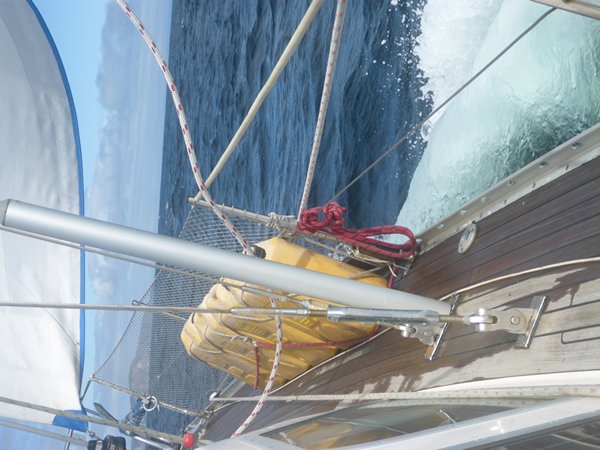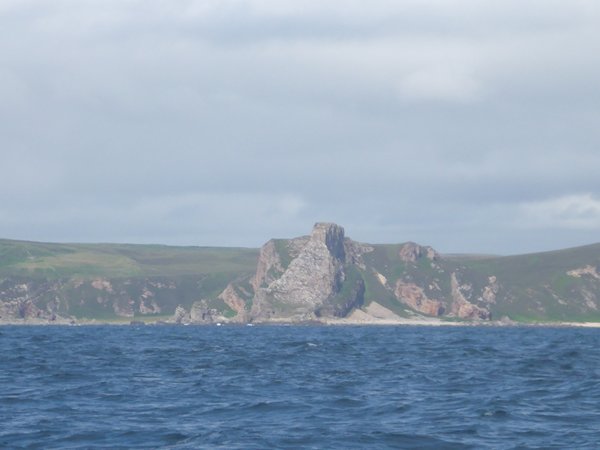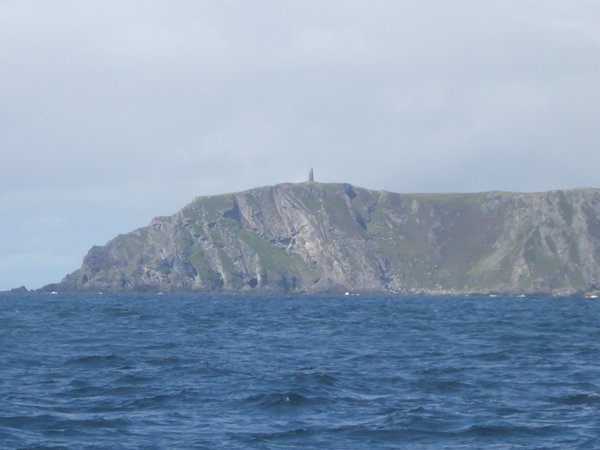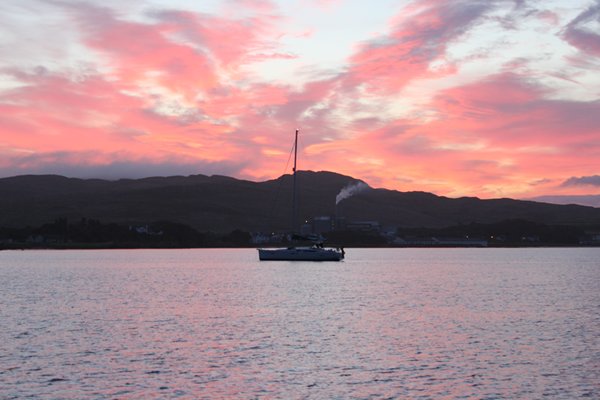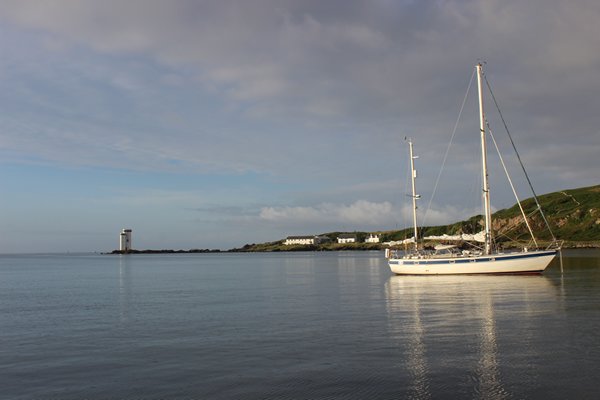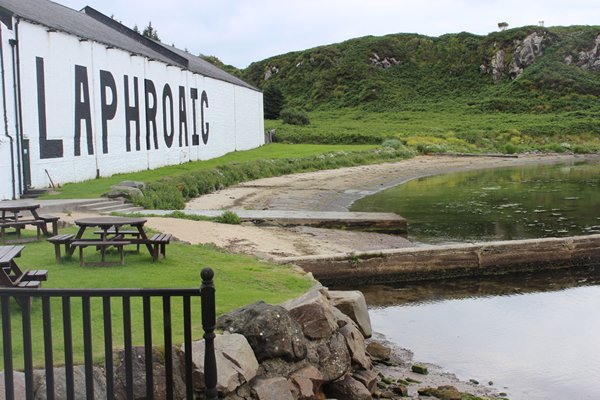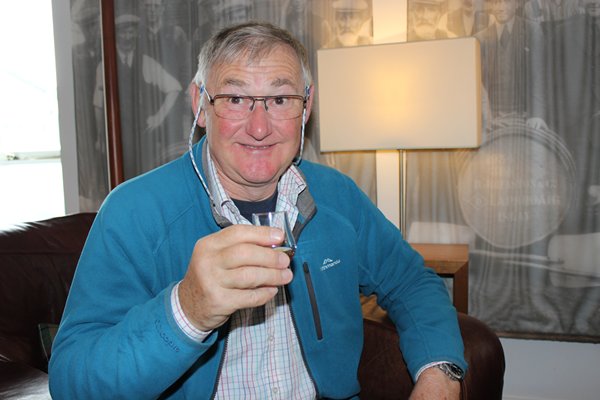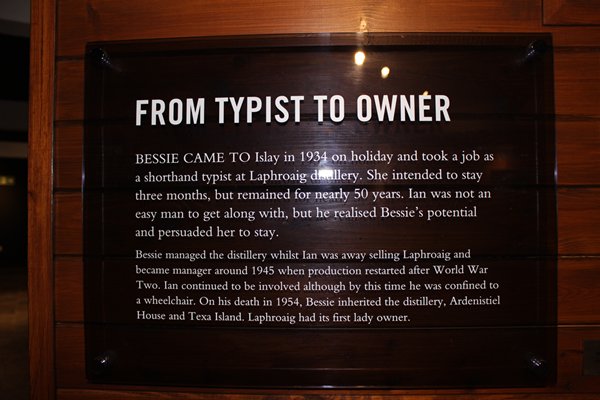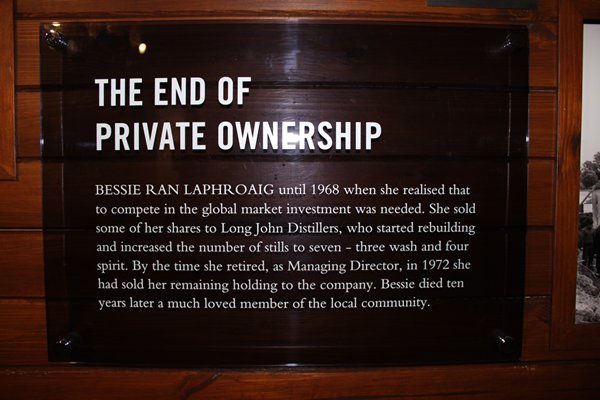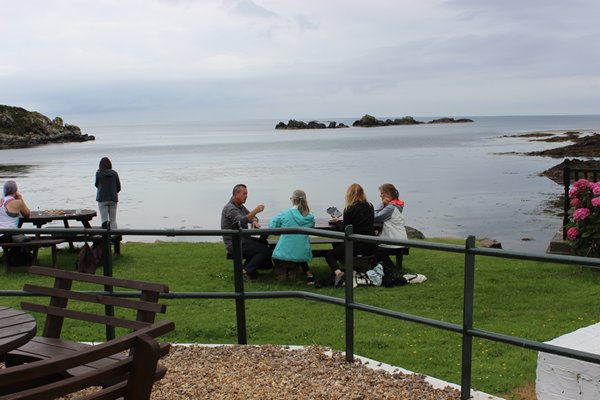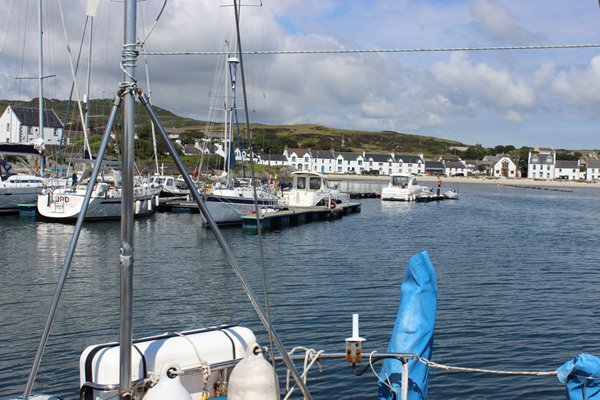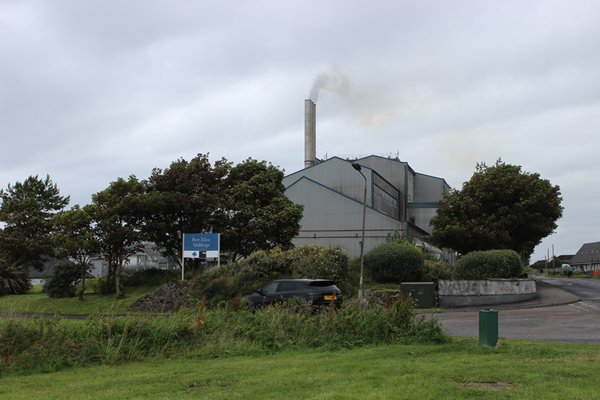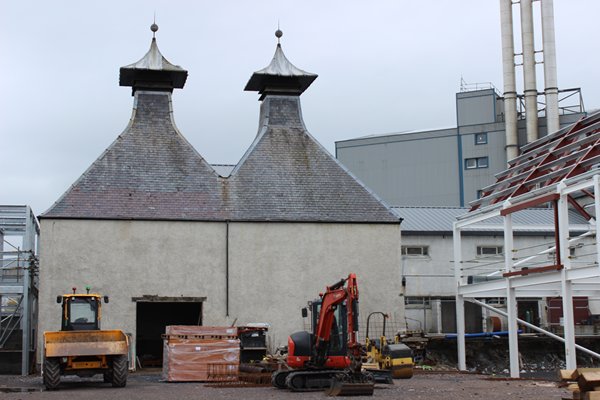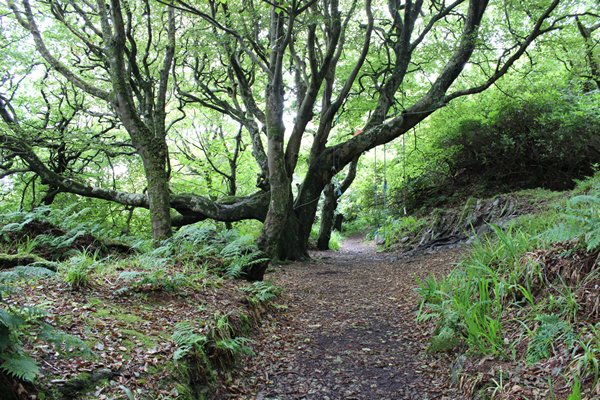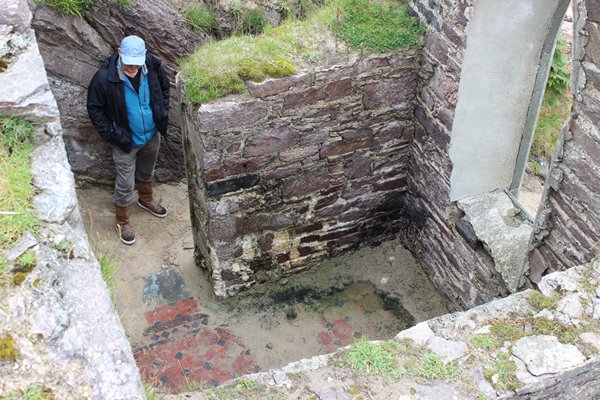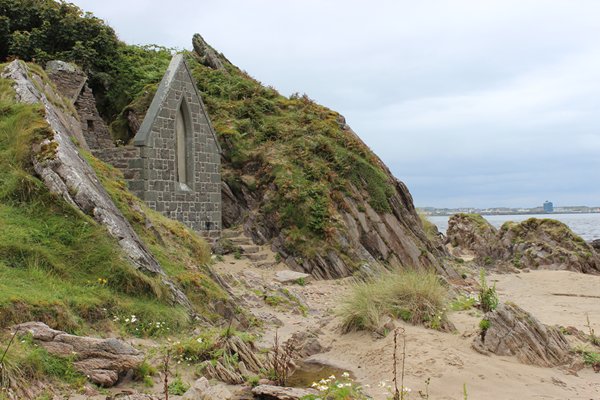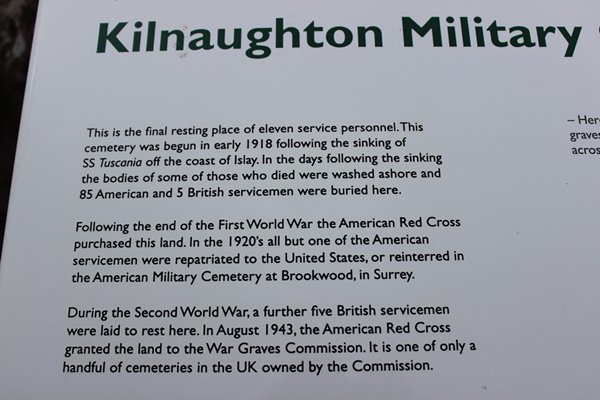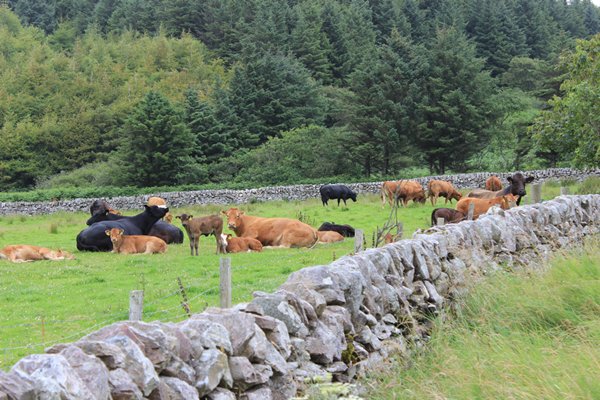Scotland Bound

Scotland Bound
Zoonie sails to Islay
Getting past Malin Head was a struggle with a wind over tide and a moderate sea to contend with Zoonie needed some help from the iron topsail. Late morning the wind started to ease and the sun came out and it was only the occasional squall that brought plenty of wind, and then with the tide trying to push us down into the Irish Sea we were ferry gliding at an extreme angle to make a course for Port Ellen. The American Monument stood high and unmissable on the headland as the Irish north coast faded into the distance.
We were proud of the fact we sailed for six of the eight and a half hours at sea and much of the motoring was out of the Swilly and past hooky Malin Head. Our Irish days behind us and with many wonderful memories stowed away, what adventures would Scotland bring, we wondered?
It was shocking and very sad to see many dead adult guillemots in the water, upside down, their beautiful white chests facing the sky and their head backwards down in the water, never to see their mountains again. What would happen to the young they were rearing; would this also be a death blow to the next generation? We suspected the Avian flu that is decimating the gannets and puffins is also taking its toll on these lovely little sea birds.
In times past yachts entering and leaving Scottish waters frequently made stopovers in Gigha Island but then at the turn of the millennium some insightful and considerate minds decided better shelter could be provided by dredging a small area of harbour bed inside the already existing harbour at Port Ellen and three pontoons were installed with 36 visitors’ moorings all of which filled up rapidly as we arrived as yet another gale was in the offing a few days later. In 2002 Chay Blyth opened the marina, he of Challenger Round the World Yachts fame; we have both done a few stints as watch leaders on his 72-foot steel clippers while volunteering for the Tall Ships Youth Trust.
We anchored in Kilnaughton Bay for our first night and on another day walked around to the bay from the marina, but first the tastings began with a visit to Helen’s front garden marquee inside which she let us sip her home-made bramble, rhubarb and barley wines. Folk from around the island bring her their pickings and she freezes them until there is enough fruit, or grain, to make a batch.
A resigned head teacher she decided to make a small business from what had been a hobby and now sells wine by the internet as well as to more local outlets including shops and the ferries and us visitors.
Then after a night to recover, we walked the asphalt track to the Laphroaig Distillery where we learned we were in the ‘silent season’, no we didn’t have to speak in defensive whispers, it meant there were no tours as there was no brewing or distilling going on because there was a lack of water in the summer months. A little disappointed we sat down with our free taster (boy that was sharp) and a selection of four whiskies to share with a packet of biscuits.
The second was the ten-year-old from a bourbon barrel which was very nice and the third, the Quarter Casket was delicious, but not surprisingly they had run out of that one so we settled on the 10-Year-Old.
The lass at the bar was knowledgeable. I asked her how they were going to manage when the ban on peat (turf in Ireland) came into force in two years’ time. She said theirs was not an industrial scale extraction so it wouldn’t affect them. Also, they harvested the peat sustainably by removing the top layer, extracting the brick shaped blocks and then returning the surface layer. The peat recovered at the rate of 1mm depth per year, she said proudly. Hang on a minute, I thought. First when you add up all the Scottish distilleries and include the new ones in the process of being built, that might well amount to industrial scale extraction and secondly, 1mm a year would take 100 years to recover at least.
Fortunately, the whisky put us into a jolly frame of mind so that even the gift of friendship, a square foot of land next to the Kilbride stream that supplies their peaty water, that would reward the ‘owner’ with a dram of Laphroaig on each visit, didn’t seem quite as childishly patronising as it really was.
By the time we had walked back to Port Ellen, past the grazing geese, we were hungry and thirsty and the genuinely friendly Islay Hotel with its chatty staff came up with a delicious plateful of baked potato and all the trimmings, as warming as the same meal in The River Inn in Derry just a few days before, washed down with a pint of the dark stuff from across the water.
Our third and final ‘tasting’ was Islay gin. A little bird had told us it was infused with heather and that concept appealed to us so we climbed aboard the number 450 and bounced over the giant peat bog that is south east Islay to Bridgend and Islay Gin. Silly me I had assumed a distillery on the scale of the whisky enterprises, but the still was of the domestic kind designed for the home kitchen and the location was a small shop. So, we had our tasting and the heather gin was so pleasant and smooth we bought a bottle and chatted with the couple in the shop and the man in the café who broke of from picture frame making to make us a cuppa, and then wandered back to await our bus.
The buses not being frequent we whiled away some time over another coffee in the hotel and worked out that it would be more fun to continue our bus ride right across to Askaig on the Sound of Islay, sit in the bus while the driver bought a pie and went for a pee, and then stay on it right back to Port Ellen, at least we would see more of the country. So that is what we did, chatting to the nice driver and noting that the island does have some lovely ancient woodland.
We spent our last day on board as the gale rocked the craft in the marina and Zoonie heaved and tugged on her lines, squeaking like a rusty gate. Finally, we ventured out in the evening to buy a takeaway Chinese, and we scoffed that as if we hadn’t eaten for a week. The last Chinese take away we had was back in Dorset and the withdrawal symptoms were acute.
Ian oversees the marina. A retired merchant seaman he is a gentle and very busy man. “I was still in bed and my phone rings, ‘Have you got a mooring?’, I am getting calls all the time,” and he was too, he had to break off from chatting to us to take more calls. He gets paid for three hours and works for twelve in the busy season, but it was with a touch of sadness that he said on our last morning, “You’ll all be leaving soon, I’ve just been asking and everyone is off.”
The early birds left to catch the last of the tide down towards Belfast and the Irish Sea, while a few of us were hanging about to leave around 11am, the tide turning from low around 10.57am.
Built in the style of a sailing trawler, in Denmark, in 1981 the Atlantica graced the harbour wall for a couple of days while we were there. I mention this not only because, as you well know I’m a sucker for traditional style sailing boats, but also because she made ready to depart just before us and moved away from the harbour wall in an attempt to turn around ready for leaving. The tide was at sand bottom, as I have mentioned, and the dredged area of usable depth in the harbour is minimal. While still well within the channel she ran aground. Not life threatening, and she was sitting in sand that might just clean her hull a little, but when a crew member in a dinghy rowed a line from her stern across the expanse of water to the harbour wall so the wind would not blow her further on, we could not leave. The first time I have been blockaded since Cherbourg back in 1981. It was simply a waiting game. A second stronger line was taken from the bow and two strong men worked together on the winch to pull her inch by inch back into deep water. The time when we were able to pass her was 10.57am.
With a gentle tide under us and a kind westerly, we sailed north in the lee of the island on flat waters, very pleasant it was too. No dead birds today just lots of other yachts, tiny white dots of sail in the near and far distance, a Caledonian Macbrayne ferry heading for the Sound of Islay altered course very slightly for us, while we sailed across the same gap and benefited from the wind funnelling down. The Lady of Avenel was tucked into a bay, bare poles like bones in the sun, will we meet again I wonder.
On approach to Craighouse on the south east corner of Jura, I spotted a small chunky black hull belching smoke heading for the same narrow entrance as we were. I racked my brain, what were they called these small cargo ships that frequented this part of the world, ‘potters’, ‘botters’ no, they were Dutch ah, of course the plume of black smoke was the clue ‘Puffers’, typically ‘Clyde Puffers’. “Coal fired, I think” Rob accurately remarked, and we followed the familiar smell into the bay in front of the Jura Distillery. I googled her and found all about Vic32 as she is called and there is an article written by Nick Walker who with his wife Rachel, restored and ran her around this area for many years. It is titled ‘Save the Puffer. History of Vic 32’ and it is a great little article. I feel privileged to be in her company.
Later last evening Vic32 played Happy Birthday on her whistle to some lucky punter spending a week on board, who would remember that birthday for the rest of their life.
I
will include a second photo file from Atlantica Aground to
Craighouse separately as this one is already big.
